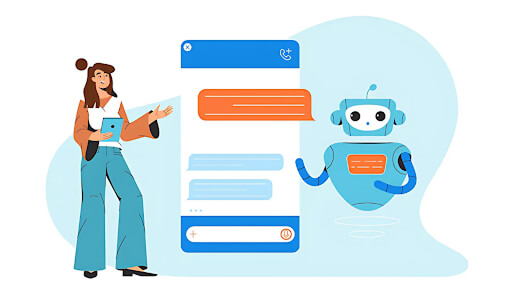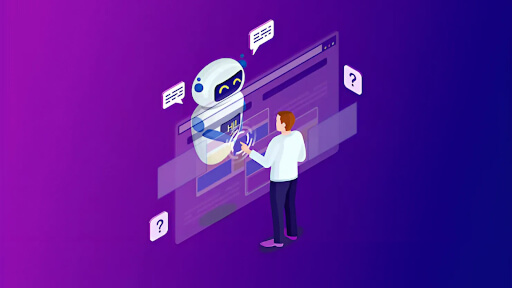 1-800-805-5783
1-800-805-5783 
AI agents are intelligent, autonomous systems designed to perceive their environment, make decisions, and act, often with minimal or no human intervention. Unlike traditional software that strictly follows predefined rules, AI agents utilize advanced technologies such as large language models (LLMs), natural language processing (NLP), and machine learning to adapt, reason, and respond in real-time.
They interpret digital inputs—like user queries or system data—process the information intelligently, and perform tasks that range from answering questions to executing complex workflows. Often integrated with APIs or external systems, AI agents go well beyond static chatbot responses to deliver highly contextual and impactful results.
Autonomy
AI agents operate independently, breaking down large tasks into smaller steps and executing them without constant input or oversight.
Reasoning and Decision-Making
Leveraging decision-making frameworks such as ReAct (Think-Act-Observe), agents solve problems in a step-by-step manner, adjusting their approach based on the outcomes.
Memory and Learning
Unlike traditional rule-based bots, agents can store and recall past interactions, learning from them to provide more tailored and effective responses over time.
Tool Integration
These systems can interact with APIs, databases, or third-party tools to perform actions like booking, analyzing, or fetching data in real-time.
Multi-Agent Collaboration
In more complex scenarios, multiple AI agents can work together—each handling a specialized task—to collaboratively solve larger problems.

Traditional chatbots excel at repetitive tasks, utilizing rule-based logic or decision trees to automate these tasks. But they fall short when it comes to dynamic conversations or multi-step tasks. AI agents, often called “agentic AI,” take things to the next level.
They’re built to:
For instance, while a chatbot might simply tell you tomorrow’s weather, an AI agent can analyze your calendar, detect a morning meeting, and recommend setting an earlier alarm due to predicted rain delays.
Upgrading a basic chatbot into an intelligent AI agent requires several key enhancements:
Incorporate models like OpenAI’s GPT, Amazon Titan, or IBM Granite for advanced conversational capabilities. These models help the system understand free-form input and respond intelligently.
Low-code frameworks, such as LangChain or LlamaIndex, can simplify integration, enabling rapid prototyping and deployment.
Add memory to help the agent recall user history and preferences. This can be done via local or cloud-based memory solutions.
Use retrieval-augmented generation (RAG) to ground answers in enterprise knowledge, ensuring accuracy and reducing hallucinations.
Agents should be able to trigger actions through APIs or external services—whether it’s updating a CRM, scheduling a meeting, or fetching financial insights.
Cloud platforms like Azure AI Agent Service or Amazon Bedrock streamline tool integrations and ensure scalability.
Adopt models like ReAct that allow the agent to think, take action, observe, and iterate. This is crucial for complex problem-solving and decision-making.
For more sophisticated use cases, consider using multi-agent systems, where specialized agents coordinate and complete shared goals.
Enable user feedback to refine agent behavior—for example, changing tone or style based on preferences.
Agents should also self-assess their interactions, identify areas for improvement, and adjust their approach based on the outcomes.
6. Ensure Governance and Compliance
Implement validation workflows (e.g., human-in-the-loop) and adhere to security standards such as HIPAA or GDPR. This is especially important in industries handling sensitive or regulated data.

Consider a retail business with a basic FAQ chatbot. To transform it into a competent AI agent, the company could:
AI agents are finding a home across industries, solving real challenges through automation, adaptability, and intelligent reasoning. Let’s explore how:

The AI agent ecosystem is evolving rapidly. Key developments to watch:
Multi-Agent Systems
Companies like Microsoft and OpenAI are deploying collaborative agent networks to handle larger, more complex workflows.
Low-Code Development
Tools like LangChain or DigitalOcean’s GenAI platform are enabling broader access, empowering non-technical teams to build intelligent agents.
Agentic Automation + RPA(Robotic Performance Automation)
Merging the adaptability of agents with RPA brings automation to dynamic, unstructured processes, not just static workflows.
Responsible Deployment
Researchers and organizations, such as the World Economic Forum (WEF) and Yoshua Bengio, emphasize the importance of ethical frameworks in guiding the deployment and governance of AI.
A notable 2024 arXiv study even introduced an “AI Scientist” capable of generating research hypotheses and autonomously running experiments. A study estimates that by 2027, half of enterprises using generative AI will have also adopted AI agents.

AI agents aren’t just an upgrade from chatbots—they’re a leap forward. With the ability to understand context, reason through tasks, and integrate with tools, they’re becoming vital to how modern businesses operate. Whether in finance, healthcare, logistics, or software, AI agents unlock new levels of efficiency and intelligence.
However, as with any powerful technology, implementation must be balanced with strong governance and ethical oversight. When done right, AI agents don’t just make operations smarter—they elevate experiences, empower teams, and future-proof businesses.
As platforms from AWS, IBM, and Microsoft continue to evolve, AI agents are set to become a staple in every digital enterprise’s toolkit.
At [x]cube LABS, we craft intelligent AI agents that seamlessly integrate with your systems, enhancing efficiency and innovation:
Integrate our Agentic AI solutions to automate tasks, derive actionable insights, and deliver superior customer experiences effortlessly within your existing workflows.
For more information and to schedule a FREE demo, check out all our ready-to-deploy agents here.